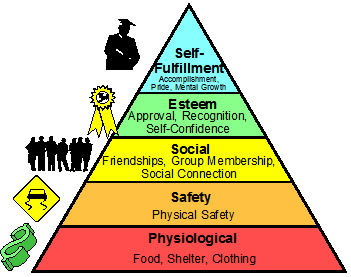History of the Human Side
Psychology & Sociology in Lean History

Lean requires high performance from everyone in an organization. It depends heavily on multiple small improvements, tight coordination good communication and cooperative problem-solving. The question is: "How do we align the work environment and the worker's basic needs to promote high-performance, team-oriented behaviors?"
A Bit of History
Until about the 1940's, most manufacturers depended on the lower physiological and safety needs to motivate employees. These lower needs tend to be fear-based, i.e. fear of starvation, financial insecurity, and fear of physical injury or sickness. At one time, there was some rationale for this approach. We will use the illustration of Ford Motor Company but most large-scale industry had similar practices.
In the early part of the Twentieth Century, Ford Motor Company became successful with the Model T and began to employ tens of thousands of workers, the company faced some serious workforce problems:
- Most laborers, particularly in Detroit, were poor immigrants from many regions of Eastern and central Europe. Few spoke English and co-workers often had no common language for daily communication.
- The workforce was largely uneducated and often illiterate, even in their native language.
- Mechanical skills were rare.
To utilize this workforce effectively, Ford Motor Company developed their mass-production methods. Tasks were divided into minute, short-cycle subtasks that repeated endlessly, 8-10 hours per day and 5-6 days per week. A culture of fear developed based on a threat of losing the job. Henry Ford introduced the $5 day because his company was having difficulty getting people to work under these conditions. It was not out of idealism as he often claimed.
There was little to appeal to the higher motivations of Maslow's hierarchy of needs. Clearly, such work was unfulfilling. There was little in the way of recognition or approval. Socialization was difficult because of the equipment arrangement and was actively discouraged by management. I recall the story of one executive who would occasionally walk through the plant and fire people who were talking or (God forbid) laughing. Henry Ford himself was reputed to have done the same.
The culture at other Detroit automobile companies was a bit better, but not much. General Motors had a veneer of civilized behavior and Packard was known as a (relatively) congenial place to work. Other large-scale industries followed the Detroit Automotive pattern in varying degrees.
The Ford system began to break down with the advent of labor unions and the welfare state. Unions offered some protection from the most outrageous abuses and they increased wages in many industries. Social Security, Unemployment Compensation and other programs reduced the impact of layoffs. In the following decades, the workface became more educated, more literate and less fearful as memories of the Great Depression receded.
Other factors were also in play. Models and options proliferated while equipment became more complex and more sophisticated. These factors required increased coordination, higher skills and motivation to perform well in all aspects of a job.
 Appealing To the Higher Needs
Appealing To the Higher Needs
Toyota was one of the first automotive firms to make widespread use of the higher motivators in Maslow's hierarchy. Ironically, it was an American who forced the change. The story goes like this...
After World War II General Douglas MacArthur was, essentially, the dictator of Japan. In an effort to break the power of Japan's military-industrial complex, MacArthur greatly increased the power of Japanese labor unions. Toyota was a smallish firm and a family-run affair with paternal instincts; hardly a major player with the Japanese zaibatsu, but Toyota was still caught up in the reform effects.
In 1950 the company faced an economic crises that required extensive layoffs and Toyota's union called a strike that became quite bitter. The strike experience shook the fundamental attitudes of both management and labor. The result was a recognition of their common goals and interests as well as a further recognition that Toyota people, at all levels, were the company's best resource. In fact, Toyota had no resources beyond their people because of destruction from the allied bombing campaign and postwar economic chaos.
Toyota's "Respect for People" philosophy became intertwined with the developing Toyota Production System and an integral and essential part of Lean Manufacturing. This "Respect For People" addresses the higher needs in Maslow's hierarchy. In the following section, we describe how the higher needs fit with each of several lean elements. These are just some obvious examples. There is actually a complex web of interaction between the Socio and Technical aspects of Lean that cannot be addressed fully in a short or even a very long article.
■ ■ ■ ■ ■ ■ ■


